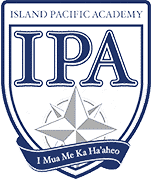Two scientists were recent guest lecturers to Island Pacific Academy science classes where they shared real life experiences and their ocean-related research work with our students.
Dr. Asashiko Taira, a geologist and professor emeritus at the University of Tokyo, presented his research with ocean drilling science to grade students. “Dr. Taira brought what is actually happening in the real world of science into our classroom. Our eighth grade science class is learning about the Pacific Ocean that surrounds us and how currents and energy travel through the oceans of the world,” says Michelle Bradley, science department chair.

Dr. Asashiko Taira, president of JAMSTEC (Japan Agency for Marine-Earth Science and Technology)–a research institute that conducts experiments and activities to promote an integrated understanding of our world in terms of ocean, earth, and life–gave an overview of his research related to the 2011 Tohokoku mega-earthquake and tsunamis. “Deep-ocean drilling by Chikyu found the cause of mega-earthquake and tsunamis of 2011, NE Japan.”
“Our students can remember the Japan earthquake in 2011 and tsunami that devastated Japan. Dr. Taira talked about what scientists thought caused the tsunami, how they hypothesized on the cause, then investigated to prove or disprove their hypothesis using deep ocean drilling on a science research vessel (the Chikyu). The eighth graders learned that how they hypothesize and experiment in our lab is the same as the way scientists in the real world perform investigations. This was a great way to link what we do in the science lab to real world scientists,” says Bradley.
 Anuschka Faucci, a biology professor at the University of Hawaii at Manoa, explained her plankton research to the grade eight class.
Anuschka Faucci, a biology professor at the University of Hawaii at Manoa, explained her plankton research to the grade eight class.
Another researcher, Dr. Anuschka Faucci, also visited and presented to the grade eight classes. Dr. Faucci, a zoologist who specializes in Marine Biology, Evolutionary Biology and Ecology, shared her recent work on the study of plankton that she conducted while aboard the Hokulea during its Malama Honua Worldwide Voyage. Island Pacific Academy is a Malama Honua school; teachers across the grades have been incorporating the Polynesian Voyaging Society‘s global voyage into science, geography, culture, and history lessons.
Faucci is part of Kahi Kai, an online community that connects people from diverse disciplines in discussion and activities about our oceans. One of the aims of Kahi Kai, which means “one ocean” in Hawaiian, is to foster interaction between students and the scientists who are studying the ocean.
“Dr. Anu (Faucci) brought samples of live plankton. She engaged our students immediately by letting them examine and view the plankton right here in our lab,” explains Bradley. “Both Dr. Taira and Faucci were impressed by our students’ genuine interest toward science.”’
Accompanying Faucci during her visit was Dr. Patricia Murata, an IPA parent. Murata, a post doctoral fellow at the Kewalo Marine Lab, is also a skilled photographer. She instructed the students on the use of a microscope with a video output which allowed them to record their examinations of different marine life slides.




